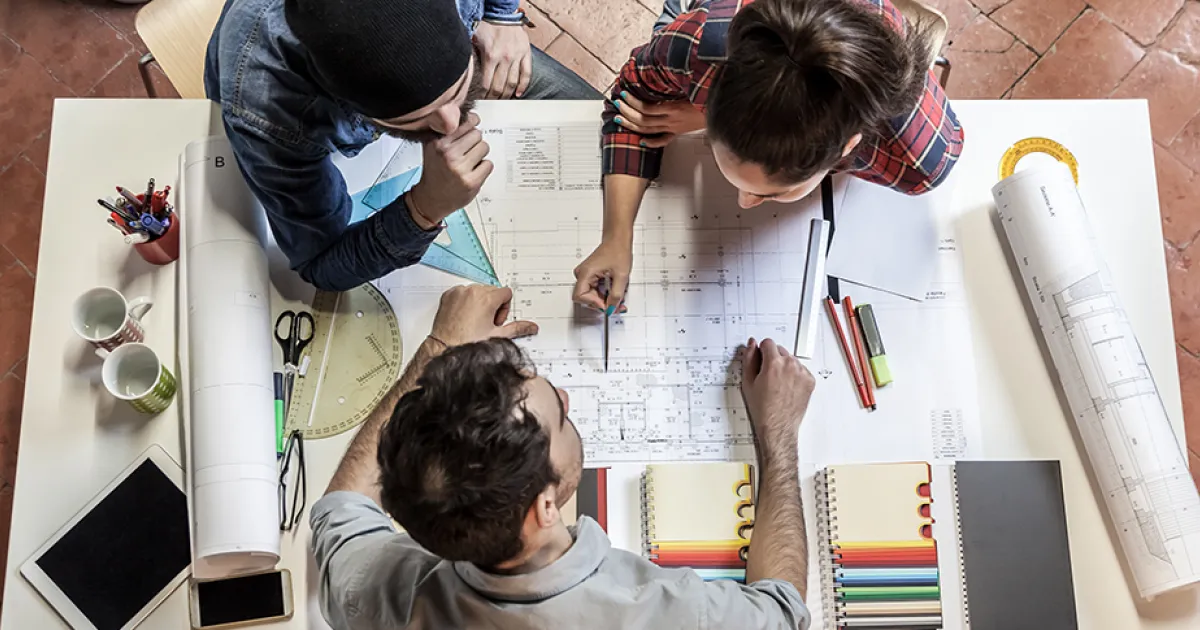Architect Workflow Enhancement for Quicker Project Delivery
Architect Workflow Enhancement for Quicker Project Delivery
Blog Article
Understanding the Diverse Job Paths Available for Aspiring Architect
As an aspiring Architect, you have a world of job paths awaiting you. Each path supplies one-of-a-kind difficulties and opportunities to apply your imagination and technological know-how. Whether you're drawn to standard design or the nuances of sustainable layout, there's a niche that aligns with your interests. Understanding these varied options can form your expert journey, however which direction will you pick to explore first?
Conventional Design: Designing Structures and buildings
Standard design concentrates on creating structures and frameworks that mix functionality with visual allure. Your styles can show social heritage, showcasing local practices while meeting contemporary needs.
You'll develop skills in preparing, model-making, and website analysis, permitting you to envision and connect your concepts efficiently. Engaging with customers, you'll need to comprehend their vision and convert it into feasible designs.
Additionally, constructing codes and sustainability techniques are necessary in your work, ensuring your frameworks are risk-free and eco-friendly. As you grow in your job, you'll find opportunities in domestic, commercial, or also repair projects, each offering distinct challenges. Welcoming standard architecture leads the way for a fulfilling job that admires the past while shaping the future.
Urban Preparation: Forming Neighborhoods and Public Spaces
As an ambitious Architect, you can play a vital function as an urban coordinator, transforming how areas operate and communicate. By employing area involvement techniques, you'll assure that citizens have a voice in shaping their atmosphere. Plus, incorporating sustainable layout principles will help create areas that not just meet today's demands but also secure the future.
Role of Urban Planners
While lots of might consider engineers as the sole dreamers behind buildings, metropolitan organizers play a necessary function fit the broader landscape of neighborhoods and public rooms. They analyze land use, zoning legislations, and community needs to develop sustainable atmospheres that improve quality of life. By collaborating with numerous stakeholders, you'll help develop parks, transport systems, and houses that promote social communication and availability. Urban organizers additionally concentrate on environmental considerations, making certain that developments integrate eco-friendly areas and assistance biodiversity. Your knowledge in spatial design and area dynamics allows you to visualize future development while maintaining social heritage. In this essential function, you'll directly influence just how individuals experience their environments, making every job a possibility for favorable adjustment.
Neighborhood Engagement Methods
Effective neighborhood involvement strategies are important for urban planners to ensure that the voices of citizens are listened to and valued in the preparation process. To promote purposeful discussion, you should prioritize open forums and workshops where neighborhood participants can share their concepts and concerns. By actively paying attention and including comments, you'll produce areas that mirror the neighborhood's needs, ultimately leading to more successful and lasting city environments.
Lasting Layout Concepts
When developing urban rooms, integrating sustainable layout concepts is crucial for creating settings that prosper both environmentally and socially. Think about integrating environment-friendly areas, like parks and yards, to improve biodiversity and improve air top quality.
Creating with water conservation in mind is likewise essential-- think regarding rain yards and permeable surfaces to manage stormwater. Entailing neighborhood participants during the preparation process guarantees that the areas you create satisfy their needs and encourage social communication. By embracing these concepts, you'll contribute to vibrant, lasting metropolitan landscapes that profit everybody.

Landscape Style: Developing Lasting Outdoor Environments
As you discover landscape design, you'll discover crucial style principles that develop attractive and useful outdoor spaces. Lasting methods play an important role in ensuring these environments thrive while decreasing ecological effect. And also, you'll discover a variety of occupation opportunities that permit you to make a genuine distinction in exactly how individuals communicate with nature.
Design Concepts in Landscape
Recognizing layout principles in landscape design is crucial for developing lasting outside settings that integrate with nature. You'll require to contemplate elements like scale, balance, and proportion to guarantee your designs really feel natural and welcoming. Furthermore, pay focus to seasonal adjustments, making with products that enhance the environments year-round.
Sustainable Practices Introduction
Lasting methods in landscape design not only concentrate on aesthetic appeals however likewise prioritize ecological health and source preservation. By integrating native plants, you enhance biodiversity and lower the demand for chemical fertilizers and pesticides. Applying reliable irrigation systems helps preserve water and lessens runoff, protecting nearby ecological communities. You can create spaces that advertise dirt health and wellness, such as using natural materials and exercising permaculture principles. Additionally, including environment-friendly facilities, like rainfall gardens and porous sidewalks, help in stormwater administration and lowers metropolitan heat. You add to a healthier planet and supply spaces that promote area connection when you develop outside settings with sustainability in mind. Eventually, these techniques guarantee your layouts profit both people and the atmosphere for years ahead.
Career Opportunities Exploration
With a strong structure in sustainable practices, landscape design supplies a variety of career paths that enable you to make a purposeful effect on the atmosphere. You might work as a landscape developer, developing cosmetically pleasing and functional outdoor spaces, or specialize in ecological remediation, assisting to revitalize broken ecological communities. Urban planners frequently collaborate with landscape designers to produce eco-friendly areas in metropolitan settings, enhancing city livability. If you're passionate concerning education and learning, take into consideration coming to be a landscape style instructor, inspiring future generations. In addition, you might function with nonprofits concentrated on ecological sustainability or engage in research to innovate brand-new techniques. Each course not only shapes beautiful environments yet additionally promotes a healthier planet for future generations.
Lasting Design: Concentrating On Eco-Friendly Practices
As you explore your profession in architecture, accepting environment-friendly practices can establish you apart in a competitive area. Lasting layout focuses on developing buildings that decrease environmental impact while boosting resident health. By incorporating sustainable products, energy-efficient systems, and sustainable structure methods, you'll add to a greener future.
Beginning by acquiring expertise of environment-friendly accreditations like LEED or BREEAM, which can strengthen your credentials. Think about just how natural light, air flow, and thermal efficiency can enhance layout. Collaborate with engineers and ecological professionals to introduce solutions that decrease waste and preserve sources.
Don't forget the importance of neighborhood participation-- interesting local stakeholders can inspire styles that balance with the atmosphere. As clients significantly prioritize sustainability, your experience in green practices will not only bring in tasks but likewise meet your enthusiasm for liable style. Welcome this essential element of the occupation, and enjoy your job prosper.
Historical Conservation: Shielding and Restoring Cultural Heritage
While you commence on your building trip, take into consideration the important function of historical preservation in preserving our cultural heritage. This field concentrates on the security and reconstruction of substantial structures, sites, and structures that tell the tales of our past. By taking part get more info in historical conservation, you'll click here assist secure the architectural legacy that forms community identification.
As a historic preservation Architect, you'll examine historic importance and analyze the problem of structures. You'll function closely with historians and preservationists to assure authentic restoration methods are used. This profession course enables you to mix imagination with study, allowing you to create services that value original products and craftsmanship.
Your work not only adds to sustainability by reusing existing structures but likewise cultivates a sense of satisfaction within neighborhoods. Welcoming this path will certainly help you end up being a guardian of background, protecting the tales and visual appeals that improve our lives.
Interior Design: Enhancing Indoor Spaces
Historical preservation and indoor style both share a commitment to improving the constructed environment, however they focus on various facets. While historic preservation highlights keeping a structure's historical and cultural value, indoor style zeroes in on enhancing interior spaces for performance and aesthetics.
As an aspiring Architect, you'll find that interior design enables you to mix creative thinking with technical abilities. You'll make rooms that not only look good but likewise advertise convenience and efficiency. This field involves comprehending exactly how light, shade, and products connect within a space, affecting mood and functionality.
You'll work with different jobs, from domestic homes to business workplaces, making certain that each setting fulfills the demands of its owners. By prioritizing user experience, you can transform interiors into motivating and useful spaces, making a significant effect on exactly how people interact with their surroundings. Welcome the chance to improve indoor environments and form the means individuals function and live.
Industrial Style: Merging Functionality With Looks
Industrial style plays a crucial duty in producing products that seamlessly mix appearances with capability, making sure that what you utilize daily is not just aesthetically appealing yet additionally useful. As an aspiring Architect, you might involve on your own in this area, concentrating on developing everything from furnishings to consumer electronic devices. Your job entails comprehending user demands, products, and producing procedures, allowing you to create innovative solutions that improve everyday experiences.
In industrial layout, you'll frequently work together with designers, manufacturers, and online marketers, making certain that your layouts are not just attractive yet additionally viable. This get more info job course supplies a vibrant setting where imagination satisfies functionality, making it a gratifying choice for engineers interested in shaping the items of tomorrow.
Frequently Asked Concerns
What Educational Certifications Do I Need to End Up Being a Designer?
To become an engineer, you'll require an expert degree in design, normally a Bachelor's or Master's. Furthermore, you'll have to finish a teaching fellowship and pass the Architect Enrollment Assessment to exercise legally.
Exist Accreditation Requirements for Various Architectural Career Paths?
Yes, there're certification requirements for numerous architectural paths. Architect. You'll require to pass examinations, complete teaching fellowships, and often pursue specialized training, relying on your selected emphasis, like landscape design, urban design, or historical preservation
What Software Program Skills Are Essential for Designers Today?

How Can I Gain Practical Experience While Researching Design?
You can acquire useful experience by interning at architectural firms, taking part in style competitions, offering for neighborhood tasks, or teaming up with schoolmates on real-world assignments. These possibilities improve your abilities and develop valuable links in the market.
What Job Opportunities Exist Outdoors Conventional Style Firms?
You can explore numerous job possibilities outside conventional design companies, like metropolitan preparation, interior layout, landscape design, construction monitoring, genuine estate growth, or even duties in sustainability consulting. Each offers one-of-a-kind difficulties and rewards.
Whether you're drawn to typical architecture or the subtleties of lasting design, there's a particular niche that aligns with your interests.When creating city spaces, integrating lasting layout concepts is essential for producing settings that flourish both ecologically and socially.As you discover landscape style, you'll uncover important design principles that produce attractive and functional outside rooms.Understanding design principles in landscape design is crucial for developing sustainable outside atmospheres that integrate with nature.In commercial layout, you'll often collaborate with marketing professionals, designers, and makers, making certain that your layouts are not just attractive yet additionally practical.
Report this page